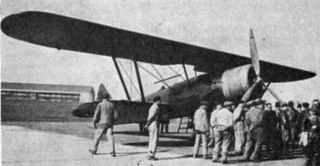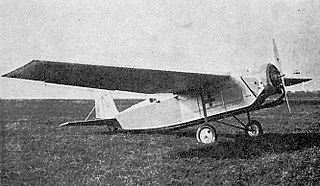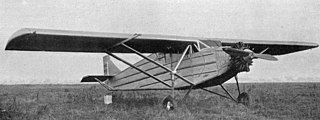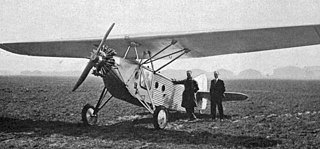Related Research Articles

The Potez 40 was a French three-engine, braced high-wing monoplane designed and built in response to a French government programme for colonial transport and policing aircraft duties.
The Caudron C.220 was a two-seat French biplane trainer. Only two were built, using different engines.
The Dupuy D-40 was a French built, low powered monoplane designed for touring abroad. The only example was used for an uncompleted journey to Saigon.

The Lorraine-Hanriot LH.70 or S.A.B. LH.70 was a French trimotor designed to a 1930 government programme for a colonial policing aircraft. Only two were built.

The Dewoitine D.430 was a three-engine, high-wing monoplane designed for policing and other roles in France's colonies. It did not go into production.
The Potez 51 was a 1930s French intermediate trainer, intended to replace the ageing Potez 25 which had sold worldwide. It did not go into production.
The Weymann W-100, Weymann CTW-100 or Weymann W-100 RBL was a French three seat observation aircraft with a position for the observer within its partially glazed fuselage. Only one was built.

The Potez 50 or Potez 50 A2 was a French two seat military multi-rôle aircraft, first flown in 1931. It did not go into service but seven variants using five different engines were produced, one of them setting several speed with useful load records and another, the Potez 506, setting three altitude world records.

The Dewoitine D.480 was a French single engine side-by-side sports and training aircraft built in the early 1930s. Two were completed and flew with several different radial engines. One remained active through the 1950s.
The Kellner-Béchereau 23 was a French two seat cabin touring aircraft, built in 1932. Its wing was constructed in a novel way. Only one was completed.
The Morane-Saulnier MS.300 and MS.301 were French parasol wing introductory trainer aircraft, first flown in 1930. They differed only in engine type. Neither reached production but were developed into two similar trainers, the MS.230 and MS.315, which were made in large numbers.

The Guillemin JG.40 was designed and built to meet a French government requirement for a small air ambulance capable of operating in the colonies. Two were completed and performed well but the JG.40 did not reach production.

The Guillemin JG.10 or Blériot-Guillemin JG.10 was a French two seat touring aircraft, designed to be as simple and safe to fly and maintain as a car, with similar facilities, as well as provision for parachutes.

The Couzinet 20 was a low power, three-engined aircraft designed in France in 1929 for postal duties, though it could have been configured to carry three passengers or as a medical transport. Variants flew with three different engines but only two airframes were completed.
The Hanriot H.34 was a basic trainer designed in France in 1924 which did not reach production. It was a parasol wing aircraft, seating two in tandem.

The Aviaméta 92 was a French, all-metal, five seat monoplane built in the late 1920s. Three different engines were fitted, and one example flew the first non-stop Paris-Algiers flight in preparation for an abandoned trans-Atlantic attempt.

The Hanriot H.46 Styx was a French, single-engined, parasol wing aircraft which could equally be configured for training, liaison or ambulance roles; in the latter form it was able to accept a patient on a stretcher. Several different engines were fitted and flown but the type did not reach production.

The Raab-Katzenstein RK.9 Grasmücke (Hedge-sparrow) was a 1920s German two-seat touring, advertising and training biplane. It was one of many designs from several countries aiming to provide low cost flying and was quite successful, with about twenty built.
The Morane-Saulnier MS.152 was a French multi-purpose aircraft built in 1928. It did not go into production.

The Albert A-10 was a four-seat French transport aircraft which could be rapidly converted into an air ambulance. Two or three examples were built between 1929 and 1932, using at least two different engines, but neither variant reached production.
References
- 1 2 3 4 5 6 Frachet, André (11 January 1934). "La limousine René Couzinet 101". Les Ailes (656): 3.
- 1 2 "Couzinet 100" . Retrieved 31 October 2016.
- 1 2 3 "Notules Techniques - Le petit trimoteur Couzinet". Les Ailes (629): 4. 6 July 1933.
- ↑ "Couzinet". Flight . XXIV (48): 1108. 24 November 1932.
- ↑ "Le Salon (image, left)". Les Ailes (597): 3. 24 November 1932.
- ↑ "Notules Techniques - en meme temps". Les Ailes (646): 3. 2 November 1933.
- 1 2 "Notules Techniques - chez Couzinet". Les Ailes (649): 18. 23 November 1933.
- ↑ "A Villacoublay". Les Ailes (664): 14. 8 March 1934.
- ↑ Bernard, Martin; Sparrow, Dave; Espérou, Bernard (March 2013). "F-1922 - The French Civil Register from 1922". Air Britain Archive: 2015/178.
- ↑ Howson, Gerald (1990). Aircraft of the Spanish Civil War. London: Putnam Aeronautical Books. p. 91. ISBN 0 85177 842 9.
- 1 2 Bruno Parmentier (23 April 2003). "Couzinet 103" . Retrieved 1 November 2016.
- ↑ Hirschauer, L.; Dollfus, Ch. (1934). L'Anné Aéronautique 1933–1934. Paris: Dunod. p. 29.